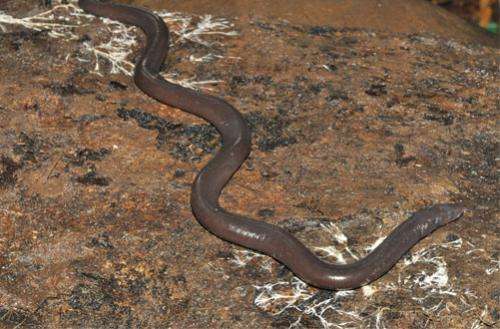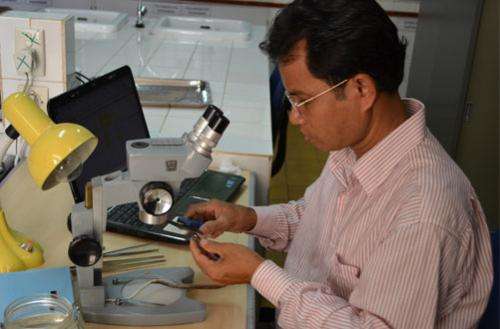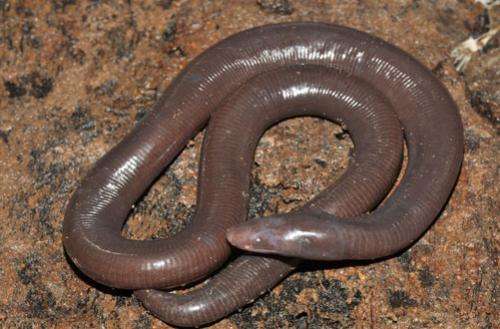Scientists discover new species of legless amphibian in Cambodia's Cardamom Mountains

Scientists have discovered a new species of legless amphibian in Cambodia's Cardamom Mountains.
The new species, Ichthyophis cardamomensis, is a caecilian, an order of limbless amphibians often mistaken for snakes, with larger species known to grow to 1.5 metres in length. This discovery, at only 30 cm, is linked to the continuing ground-breaking work at the Centre for Biodiversity Conservation (CBC) in Phnom Penh, a joint initiative of Fauna & Flora International (FFI) and the Royal University of Phnom Penh (RUPP).
Leading Cambodian FFI herpetologist Neang Thy has been researching amphibians and reptiles since 2003 and is very excited that the I. cardamomensis species has been officially confirmed. This discovery is one of three new species of unstriped Ichthyophis caecelians (the other two were found in Vietnam) introduced in the 'New Ichthyophis species from Indochina' paper published recently in the Organisms Diversity & Evolution scientific journal (published by the Society for Biological Systematics).
Between 2009 and 2011, Cambodian species samples were collected by Neang Thy and Dr Lee Grismer from the US La Sierra University with final confirmation from lead paper author, Dr Peter Geissler from the State Museum of Natural History Stuttgart, Germany.
Why caecilians are important to conservation
The I.cardamomensis species is only the second caecilian species ever discovered in Cambodia. The other is the striped Koa Tao Island caecilian, I. kohtaoensis, which is also found in, Laos, Myanmar, Thailand, and Vietnam.

"These discoveries are important to demonstrate that much of Cambodia's biodiversity remains unknown and unstudied by science, and many more areas need to be searched," Thy said.
The forested Cardamom Mountains Range represents some of the largest remaining areas of habitat for more than 80 threatened species, including Asian elephant and gaur.
Thy said in recent years the Cardamom region had revealed its extensive reptile and amphibian diversity, including frogs, turtles, lizards and crocodiles.
"We are still learning about this area and the animals in it, since it was a region formerly held by the Khmer Rouge and the mountains were closed to researchers until the 1990s," he said.
"The Cardamom region it is under threat from logging, land concessions, and other habitat destruction, and the danger of any new species, including the new caecilian, is that they may be discovered one year and go extinct the next."
Caecilians have a valuable role in the ecosystems of tropical and subtropical regions, including providinga food source for the red tailed pipe snake (Cylindrophis ruffus). Caecilians eat invertebrates, such as earthworms, ants and termites.
Speaking the science of caecilian

Caecilians are a difficult group to describe as they look so similar, and there are few caecilian experts, so comprehensive morphological and molecular (DNA) analyses is needed to recognise a new species.
Zoologist Dr Peter Geissler said caecilians of the genus Ichthyophis were some of the most poorly known amphibian taxa within Southeast Asia.
"Three distinct unstriped Ichthyophiid species – I. cardamomensis from western Cambodia, I.catlocensis from southern Vietnam, and I.chaloensis from central Vietnam are now described as new species, almost doubling the number of Ichthyophis species known from the Indochinese region, " he said.
Caecilians are best described as snake or worm-like amphibians that lack limbs. They have the typical amphibian skin that clearly differs from snakes, and they have skull and bones which differs from worms.
More information: "New Ichthyophis species from Indochina (Gymnophiona, Ichthyophiidae): 1. The unstriped forms with descriptions of three new species and the redescriptions of I. acuminatus Taylor, 1960, I. youngorum Taylor, 1960 and I. laosensis Taylor, 1969." Organisms Diversity & Evolution, December 2014. link.springer.com/article/10.1007%2Fs13127-014-0190-6#
Provided by Fauna & Flora International





















